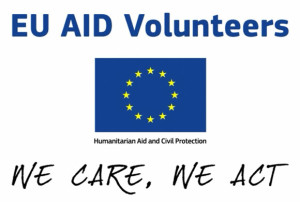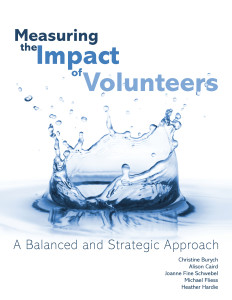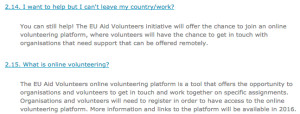 Founded in 1991 as a temporary shelter for Somalis fleeing horrific violence in their homeland, the Dadaab complex in Kenya now houses nearly half a million refugees, and is supported by a variety of international agencies, including the United Nations. Children have been born there and grown up there – it’s the only home they’ve ever known. Conditions there are often deplorable. Ben Rawlence profiles nine of the camp’s residents in his new book, City of Thorns, and details the profound challenges in providing even basic services there, let alone helping refugees get out of their precarious situation. Rawlence was interviewed on the radio show Fresh Air (the broadcast is available for free online). And his comments about volunteers in the camp grabbed my attention – and not for the right reasons.
Founded in 1991 as a temporary shelter for Somalis fleeing horrific violence in their homeland, the Dadaab complex in Kenya now houses nearly half a million refugees, and is supported by a variety of international agencies, including the United Nations. Children have been born there and grown up there – it’s the only home they’ve ever known. Conditions there are often deplorable. Ben Rawlence profiles nine of the camp’s residents in his new book, City of Thorns, and details the profound challenges in providing even basic services there, let alone helping refugees get out of their precarious situation. Rawlence was interviewed on the radio show Fresh Air (the broadcast is available for free online). And his comments about volunteers in the camp grabbed my attention – and not for the right reasons.
In October 2011, security conditions in the Dadaab camp changed drastically after the kidnapping of two Spanish aid workers by al-Shabab, the radical self-described Islamist group. The kidnapping caused the U.N. to evacuate much of its international staff and shut down all non-lifesaving activities, such as counseling, sanitation support, public health education, fuel deliveries to the boreholes to pump water, schools, and training. Food rations continued, distributed by refugee volunteers, and the hospital was staffed by just a skeleton staff, providing minimal medical care. Rawlence explained this in the Fresh Air interview – the emphasis is mine:
In order to fill the gap, the refugees themselves had to step up and run things… Life deteriorated quite quickly. The situation in the hospitals became quite critical. Their water shortages were very grave. The food continued as normal, but there was an outbreak of cholera right afterwards because the kidnapping coincided with the rainy season. And the capability to deal with the cholera outbreak wasn’t there. So for about four to five months, the camp was plunged into a real crisis. And the aid agencies issued several warnings, saying that, you know, life can’t go on like this. We’ve really got to turn things around… What really happened was that a new model emerged where the camp was run by refugee volunteers. And the agencies realized that instead of paying expensive Kenyan or expatriate staff to run services that they could rely on cheap volunteers and pay them stipends. So while the services themselves are back and running, it’s not quite how it used to be. And although the refugees are happy because there’s perhaps more work for them, there is less depth of expertise. There are, you know, not so many foreign qualified nurses and so on that there need to be. So things have moved to a much more sort of shaky footing.
I think it’s absolutely required to involve refugees in the work of running the camp – and in decision-making regarding the camp. Creating volunteering opportunities for refugees, particularly the teenagers, is not just nice, but vital. But to staff positions with refugee volunteers – people living in extreme poverty, desperate for paid work – specifically so that money can be saved by not bringing in much-needed expert staff? That’s absolutely outrageous.
Now, to be fair, Rawlence is calling these people volunteers, and others call them refugee incentive workers. This is a class of worker used by the UN and other international NGOs that’s meant to get around government restrictions regarding refugees undertaking paid work. Refugees, per Kenyan law, cannot receive salaries, even if those payments are coming from international agencies; however, refugrees are permitted to receive what are termed as incentives or stipends. These stipends are nowhere near what a salary would be for the work they do as community health workers, carpenters, masons, security guards, teachers, nurses, clinical officers, water engineers, sanitation workers, etc. – and nowhere near what these people need to support themselves and their family. They workers also receive no minimum hours of work, maternity leave or sick leave. Kakuma News Reflector – A Refugee Free Press blogged about this – and not kindly, and explains the perils for refugees in this situation quite well.
There’s a lot wrong with this situation – the primary problem is the horrific conditions refugees are facing and the impossible nature of their circumstances in terms of getting proper access to work and education opportunities, proper healthcare and proper security. But the words being used regarding these stipended workers is also troubling – this is not at all what volunteering is supposed to be.
Also see:
UN Agencies: Defend your “internships”
 If your organization or initiative is based in Europe, in a country that is a part of the European Union, and is also working in humanitarian action or civil protection or volunteer engagement, you can take a free online course to explore becoming an EU Aid Volunteers sending organization. The course will run from 2-29 May 2016, with participants logging on for approximately 3 hours per week for lessons, webinars and discussions. There is a limit of one participant per organization. Space is limited and will be allocated on a first come, first served basis!
If your organization or initiative is based in Europe, in a country that is a part of the European Union, and is also working in humanitarian action or civil protection or volunteer engagement, you can take a free online course to explore becoming an EU Aid Volunteers sending organization. The course will run from 2-29 May 2016, with participants logging on for approximately 3 hours per week for lessons, webinars and discussions. There is a limit of one participant per organization. Space is limited and will be allocated on a first come, first served basis!




